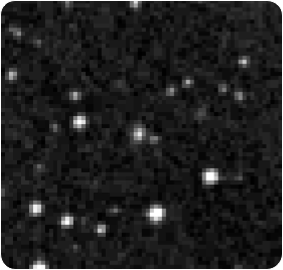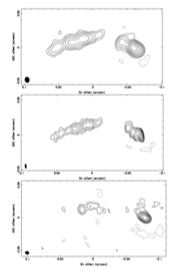






Flux data
Available Data Downloads
Images, Maps, Spectra and SEDs


Infrared data
Radio data
Optical data
X-Ray data




PKS1549-79
High-resolution VLBI radio maps of PKS 1549−79. The upper map is for a frequency of 2.3 GHz excluding the Hartebeesthoek antenna, the middle map is also for a frequency of 2.3 GHz but including the Hartebeesthoek antenna, while the lower map is for an observation frequency of 8.4 GHz (contours: −10, 10, 20, 40, 80, 160, 320, 640 and 1280 mJy Beam−1).
![Wavelength/
Frequency Flux Units Reference
5GHz 4.47 Jy Morganti et al. (1993)
[OIII] λ5007 -13.73 Log erg/cm2/s Tadhunter et al. (1993)](PKS1549-79_files/shapeimage_14.png)


Other name:
Redshift:
RA (j2000):
Dec (j2000):
Optical class:
Radio Class:
0.150
15 56 58.9
-79 14 04
NLRG
core/jet
-

N

E


N

E
UK Schmidt image, λ 4680A, width 2 arcmins.


Notes
The narrow emission-line properties of this extraordinary flat spectrum radio galaxy have been discussed in detail by Tadhunter et al. (2001) and Holt et al. (2006). It is likely that this is an intrinsically compact radio source in which the radio jets are pointing close to our line of sight, but the quasar nucleus is entirely extinguished by dust on a kpc scale. No broad permitted lines are detected in our optical spectra of this source, and we detect no significant UV polarization in our observations (Tadhunter et al. 2002). However, di Serego Alighieri et al. (1997) report significant optical polarization at the ∼3 per cent level in both the optical continuum and [OIII] emission lines in their smaller aperture observations. This polarization could have either a scattering or a dichroic origin, however, it is unlikely that the polarized component dominates the UV excess. Both our continuum modelling, and the detection of Balmer lines in absorption in the higher resolution observation of di Serego Alighieri et al. (1997) are consistent with a starburst dominating the optical/UV continuum in this source. The optical spectrum reveals rich, high-ionization emission lines. The ‘narrow’ emission lines are relatively broad.
The radio source associated with the ULIRG PKS1549-79 has a compact, one-sided jet morphology, and a relatively flat radio spectrum. Optical observations demonstrate that the quasar nucleus in this object – detected at near-IR wavelengths – drives powerful outflows in the form of blueshifted high-ionization emission lines (Tadhunter et al. 2001; Holt et al. 2006). The optical morphology of the object is highly disturbed, with double tidal tails to the south of the nucleus, a jet-like feature of lower surface brightness to the north and evidence for dust lanes in the near-nuclear regions. (Holt et al. 2006; Batcheldor et al. 2007). Overall this object has all the characteristics expected for a young quasar triggered in a major galaxy merger.
Spectral synthesis modelling of the spectrum of the nuclear regions by Holt et al. (2006) provides evidence for a YSP of relatively young age (0.04–0.1 Gyr). To refine the YSP age estimates, and look for possible spatial gradients, we have modelled the spectrum of an extended aperture of width 2 arcsec centred 2 arcsec (4.5 kpc) to the north of the nucleus along PA0 (Tadhunter et al. 2011). The latter was extracted from a VLT/FORS1 long-slit spectrum taken in excellent seeing conditions in 2003, and has the advantage that is much less affected by AGN-related continuum and emission line components than the nuclear aperture. We find that the age of the YSP in this extended region (0.06–0.08 Gyr) is entirely consistent with that determined in our earlier study of the nucleus.

2.3 GHz VLBI radio map